Library of Congress's Blog, page 176
April 1, 2013
A Capital Team
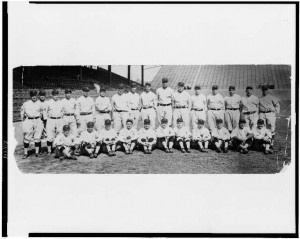
Washington Senators baseball team. Between 1909 and 1932. Prints and Photographs Division.
Baseball is certainly on the minds of sports enthusiasts as Opening Day is today. And, the Washington’s Nationals join most Major League Baseball teams in kicking off the season.
Washington, D.C. actually has a long and storied baseball history. Formed in the late 19th century, the District’s teams have used both the names “Nationals” and “Senators” and often interchangeably. The ‘Nats didn’t appear to make a name for themselves until 1886 as a member of the National League. They folded in 1889, after finishing last.
Two years later, the team was resurrected as the Washington Statesmen with the American Association. The association went bust after that season and back went the team to the National League as the Senators.
The Senators did not fare well in their nine years as a franchise, never finishing .500 or better. In 1899, the National League reduced its number of contracted teams from 12 to eight, and the Senators ended up striking out.
In 1901, the second iteration of the team returned with the debut of the American League. Once said to be “first in war, first in peace and last in the American League,” the franchise would remain in the capital until 1961, when they moved to Minnesota to become the Minnesota Twins.
Despite their history as a consistently losing team, the Senators managed to win the 1924 World Series and pennants in 1925 and 1933, thanks in part to such Hall-of-Famers as Walter Johnson and Joe Cronin.

Roger Peckinpaugh is tagged out at home plate during game between Washington and the Philadelphia Athletics. Ca. 1924 or 1925. Prints and Photographs Division.
An expansion team came to bat following the Minnesota departure. This third version of the Senators stayed in town until 1971, when they moved to Texas and became the Rangers.
According to the Sports E-Cyclopedia, the team’s last game on Sept. 30, 1971, against the New York Yankees saw a riot as angry, jilted fans continually disrupted play by throwing things onto the field. At the ninth inning, the Senators were leading but unruly fans streaming onto the field caused the game to be forfeited as order was unable to be restored.
Washington Senators baseball played host to many lawmakers of the country over time. Eleven presidents of the United States, three vice presidents, a speaker of the House of Representatives and a Canadian prime minister, among others, all threw out the first pitch to help open the season.
Washington wouldn’t see baseball on its turf again until 2005, when the Montreal Expos became the Washington Nationals, who are a member of the East Division of the National League of the MLB.
In 2012, the Washington Nationals beat the Los Angeles Dodgers, becoming the first D.C. team to advance to the postseason in 79 years. They went on to win the National League East Division but lost to the St. Louis Cardinals in game five of the National League Division Series.
An interesting sidebar: The Broadway musical, “Damn Yankees,” was inspired by the competitive struggles of the Washington Senators. “You Gotta Have Heart,” one of the songs from the musical, is often played at baseball games.
If you want to read actual sports headlines from the bygone days of your favorite team, head to Chronicling America and search through its historical newspapers.
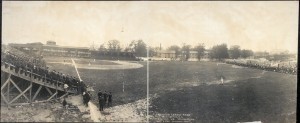
American League Park, Washington, D.C., Philadelphia vs. Washington. May 6, 1905. Prints and Photographs Division.
The Library of Congress publication, “Baseball Americana,” draws upon items from its baseball collection – the world’s largest – to tell the story of America’s favorite pastime. From baseball’s biggest stars to sandlot street urchins, from its most newsworthy stories to Little-League games, the book tells the history of the sport’s hardscrabble origins, rich cultural heritage and uniquely American character.
Want to see more? We’ve gathered a variety of our online resources on baseball here.
March 29, 2013
Opening Day Redux for President Taft
With the start of the baseball season imminent, our national pastime is in the air and on our minds. The following is a guest post by the Library’s Director of Communications, Gayle Osterberg.
Good news, Washington baseball fans: the Washington Nationals come home today, closing out their pre-season schedule against the New York Yankees.
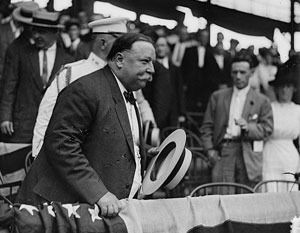
President William Howard Taft at the Washington-Chicago baseball game, August 13, 1912. Bain Collection, Prints & Photographs Division
Today will also mark the inaugural Presidents Race at the ballpark for the 2013 season, and the first appearance of a fifth presidential runner, President William Howard Taft. Those who have not had the opportunity to enjoy a baseball game in Washington may not be familiar with the presidential races, which up until this season have featured four of our most iconic leaders rendered in mascot form – George Washington, Abraham Lincoln, Thomas Jefferson and Theodore Roosevelt – running via video from points around the Nation’s Capital, entering the stadium, and racing around the perimeter of the field to a big finish.
The addition of President Taft to this season’s running presidents line-up no doubt got many Washingtonians wondering, Why Taft? Since I have the great privilege of working at a knowledge center that houses the papers of our first 23 presidents, including Taft, I decided to dig deeper.
Turns out, although baseball dates back to the 18th century, President Taft was the first American president to embrace and support the sport in a very public way.
President Taft threw out the opening day pitch two seasons in a row in Washington – April 14, 1910, and again April 12, 1911, according to his diaries – the first President to do so, according to the Library of Congress’ book Baseball Americana.
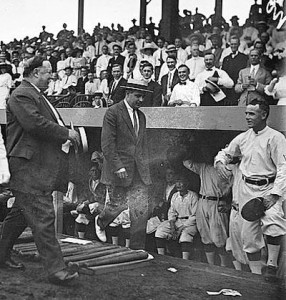
President William Howard Taft greets Washington baseball players at the Washington-Chicago baseball game, August 13, 1912. Bain Collection, Prints & Photographs Division
The 1910 game resulted in a 3-0 win for the Washington Senators over the Philadelphia Athletics. The lead of the Washington Herald’s front-page coverage of the victory, says “With the President of the United States, Vice President Sherman, and all the big men of the country looking on, the Nationals opened the American League baseball season of 1910 here yesterday by splashing a can of whitewash over the Philadelphia Athletics, 3 to 0.”
In Taft’s papers is correspondence to the day’s star, pitcher Walter Johnson, who pitched a no-hitter. After the game’s conclusion, Johnson wrote Taft that very day asking for the ball from the opening pitch with Taft’s autograph. Taft obliged and sent the ball to Johnson the next day. The accompanying letter includes a copy of the inscription on the ball:
“For Walter Johnson with the hope that he may continue to be as formidable as in yesterday’s game. W.H. Taft, April 15, 1910.”
Taft’s personal assistant, Major Archibald Butt, typed entries for the official diaries and recorded the 1911 game in a somewhat perfunctory manner:
With the President was Senator Crane, his Secretary, Mr. Hilles, General Clarence R. Edwards, and His Personal Aid, Major Butt. The President was handed the ball which was to open the game and he tossed it into the diamond.
The game was concluded at 6 o’clock, the score being 8 to 5 in favor of Washington.
An accompanying article from the Washington Herald pasted into the book is a little more colorful, with a headline and three subheads:
THOUSANDS SEE OPENING GAME AND VICTORY
Demonstrations Unequaled in History of Fandom in Capital City
PRESIDENT TAFT TOSSES FIRST BALL
Grand Principle of the Equality of Men Demonstrated in the Mixture of Statesmen, Millionaires, and Social Favorites with the Humble Citizen and Ne’er-do-well
The President did not confine his fandom to the Nation’s Capital. In May, 1910, his calendar resembles that of someone setting out to see a game in every ballpark in a single season.
He attended a game in Pittsburgh – the defending World Series champions – May 2, then traveled to St. Louis May 4, where he first watched the Cardinals played the Reds of Cincinnati (Taft’s hometown) followed by a trip across town to watch the St. Louis Browns play Cleveland.
The President was back in Washington May 24 when, his diary notes, he received the newly appointed Minister of Spain in the Blue Room, and later the Minister from Honduras. Then at 4 he left the White House to attend a game versus Detroit, which was described as “an interesting one.” At the conclusion of the 3-2 Washington win – called after six innings due to rain – the President, “at the request of management,” greeted members of both teams before heading to dinner. Among the Tigers playing that day: the legend Ty Cobb.
Welcome back to Washington baseball, President Taft. Here’s to many more memories.
Here are some more links where you may find information on your team or baseball in general:
Historic Baseball Resources
Baseball Americana (book)
Chronicling America (newspapers)
Benjamin K. Edwards Baseball Card Collection
The Business of Baseball (Business & Economics Research Advisor)
March 28, 2013
Mary Pickford: Queen of the Movies
The following is an article written by Christel Schmidt of the Library’s Publishing Office, who has edited a book on Mary Pickford, for the March-April 2013 issue of the Library of Congress Magazine.
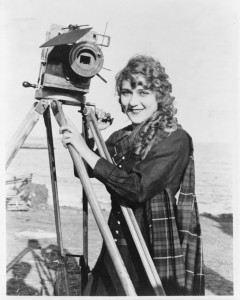
Mary Pickford with a movie camera in 1916. Prints and Photographs Division
It has been 100 years since Mary Pickford was first dubbed the Queen of the Movies. At the time, the phrase simply noted her popularity in the huge field of actors who appeared in short films shown at nickelodeons. Though it was a gratifying compliment, the title had inherently ignoble associations. After all, most people considered the movies to be a low form of entertainment. Pickford winced at the label, but it was remarkably prophetic of her future triumphs.
As the movies expanded to feature length, Pickford’s skyrocketing fame created box-office gold; meanwhile, her widely heralded acting prowess advanced the medium’s quest for respectability. In 1915 Pickford formed her own corporation and began hardball negotiations with her studio, Famous Players. This led to a landmark film contract the following year, in which Pickford received her own production unit, a strong creative voice in the making of her movies, and a salary rivaled only by that of Charlie Chaplin. Just two years later, she left Famous Players for First National in a deal that gave her complete creative control and more money. Then, with the ink barely dry on her contract, she became involved in plans to form a new company, United Artists, which she cofounded with Chaplin, actor Douglas Fairbanks, and director D. W. Griffith in 1919.
From 1910 to 1920, the fervor of Pickford’s massive fan base never wavered. In fact, the craze amplified, especially when the Queen of the Movies—a title that now defined her position as both an industry leader and a superstar—married Fairbanks. As Hollywood’s most popular leading man, Fairbanks was a king in his own right, and he shared Pickford’s passion for filmmaking. The pair became the first celebrity supercouple; their movies spread American culture and values around the world and made them the nation’s unofficial ambassadors. During their international travels, they were coveted guests of royalty, presidents, and prime ministers. At home, they ruled Hollywood from Pickfair, their Beverly Hills mansion, which became a social center for the cultural elite.
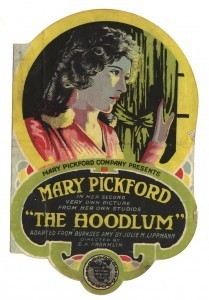
Promotional flyer for “The Hoodlum” (1919). Prints and Photographs Collection
By the mid-1920s, newer and younger stars were challenging Pickford’s box-office supremacy. Several—including Clara Bow, Colleen Moore, and Gloria Swanson—temporarily won the mantle of movie queen, but Pickford remained an enduring favorite. Then, suddenly, the industry underwent a radical change: silent film was out and the talkies were in. Within a few years, most of the era’s great stars had toppled from their lofty positions, and Pickford’s acting career and marriage faltered. During the Depression, she sought refuge in new ventures—forming a cosmetics company, performing on radio and writing books. These projects met with varying success, but none captured her soul as the movies had. Though she continued to work with United Artists and occasionally produced films for other people, nothing matched the thrill of creating her own. A decade of professional disappointment was matched by profound personal losses; her mother, Charlotte, died in 1928, followed by her younger siblings, Jack and Lottie, in 1933 and 1936, respectively. Fairbanks died in 1939. These painful events exacerbated a growing struggle with alcohol that plagued her until the end of her life.
Meanwhile, Pickford’s on- and off-screen achievements were fading from memory. Silent film, an art form she had helped pioneer and later dominated, was considered archaic. Fearing ridicule, Pickford did not allow her work to be exhibited in the rare revival screenings of silent films. Unfortunately, this lack of access prevented generations of moviegoers from discovering her work and allowed a distorted view of her movies to take hold.
The centenary in 2009 of Pickford’s first movie appearance prompted the publication of “Mary Pickford: Queen of the Movies”—a celebration of one of early cinema’s key figures. In a series of insightful essays, Pickford scholars (past and present) delve into her onscreen persona, her impact on modern celebrity culture, and her transformation from popular actress to national icon. Her frequent turns in nonwhite roles and as teenagers are explored, as is the glorification of the Pickford curls and her companionate marriage to Fairbanks. Other pieces examine her role as a Hollywood philanthropist and her interest in the fledging archival film movement and the preservation of her film legacy.
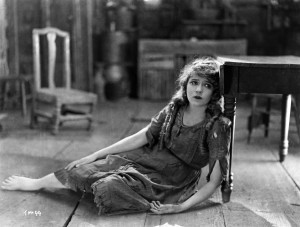
A scene from Mary Pickford’s “Tess of the Storm Country” (1922). Academy of Motion Picture Arts and Sciences
Pickford’s life and career are illuminated by the presentation in the book of more than 235 images and illustrations. Most are from the personal collections of films and photographs she donated to the Library of Congress and the Academy of Motion Picture Arts and Sciences, respectively. Her collection of costumes and other memorabilia, housed at the Natural History Museum of Los Angeles County, is also showcased. Together, these magnificent images and revealing essays offer a fascinating portrait of a brilliant woman whose influence on the film industry remains unmatched.
MORE INFORMATION
Audio-Visual Conservation at the Library of Congress
A download of the March-April issue of the LCM is available here. You can also view the archives of the Library’s former publication from 1993 to 2011.
March 26, 2013
Pic of the Week: Country Crooners
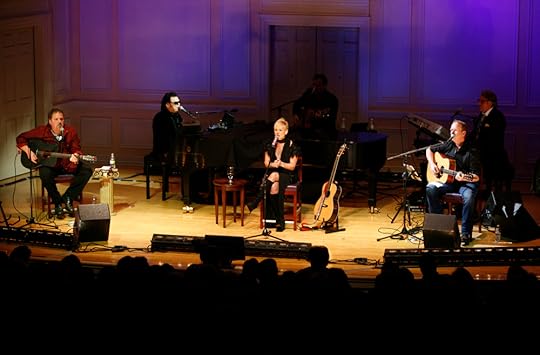
Country music singer-songwriters, Bob DiPiero, Ronnie Milsap, Lorrie Morgan and Jim Beavers perform on the Coolidge stage during the 2013 Country Music Association’s Songwriters Series Concert. Photos by Abby Brack Lewis
The Library of Congress Coolidge Auditorium turned Grand Ole Opry for a night last Wednesday, as members of the Country Music Association (CMA) took to the stage to sing their hits. Bob DiPiero returned to host the latest installment of the CMA Songwriters Series, which this time featured Ronnie Milsap, Loretta Lynn “Lorrie” Morgan and Jim Beavers. The concert series debuted in 2010.
Concerts are recorded and most are later made available on the Library of Congress website. Previous years’ concerts can be viewed here.
March 22, 2013
Four Score and Seven Years Ago …
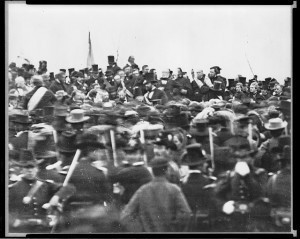
Abraham Lincoln delivers the Gettysburg Address. Prints and Photographs Division.
The Gettysburg Address, which Abraham Lincoln delivered on Nov. 19, 1863, at the dedication of a national cemetery at the Gettysburg battlefield – the site of one of the bloodiest battles of the Civil War – is recognized as a literary masterpiece and one of the most important speeches in American history.
In three brief paragraphs, the president proclaimed the principles upon which the nation was founded, honored the men who had given “the last full measure of devotion” in its defense, and challenged all citizens to a renewed commitment to freedom and democracy.
The Library of Congress will display the John Hay copy of the Gettysburg Address for six weeks, starting today through May 4, in its “Civil War in America” exhibition, located in the Thomas Jefferson Building. The Library also will extend the exhibition from its original closing date of June 1, 2013 to Jan. 4, 2014.
The John Hay copy of the address is one of five known manuscript drafts and is considered the second draft, made by Lincoln shortly after his return to Washington from Gettysburg. Lincoln gave the copy to Hay, one of his two secretaries. Hay’s descendants donated the copy to the Library of Congress in 1916.
The Library also holds the earliest known of the five drafts – known as the Nicolay Copy – of the Gettysburg Address. Lincoln’s other secretary was John Nicolay, whom this copy was entrusted to.
March 21, 2013
The Greatest Scream in Rock ‘n’ Roll History?
Duke Ellington has been famously quoted as saying: “If it sounds good, it is good.”
Which brings us to Topic A of today: What’s the greatest scream in rock ‘n’ roll history?
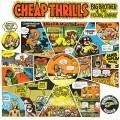
Janis Joplin said it all — vocally, but wordlessly — at the end of “Piece of My Heart”
In my own mind, it’s a tossup which of these is No. 1 — Janis Joplin’s soul-scraping vocalization at the end of “Piece of My Heart” or John Lennon’s wordless reveille at the opening of “Revolution.” Joplin’s amazing album with Big Brother and the Holding Company, “Cheap Thrills,” has been named to the National Recording Registry for 2013 by the Librarian of Congress.
There’s a lot of other fantastic stuff on this year’s recording registry – bet you can find personal connections to a bunch of it, too. Pink Floyd’s “Dark Side of the Moon” – my college roommate played that album end-to-end daily for six months, but it was OK, because it was really good. Harking back a bit more, Artie Shaw’s “Begin the Beguine” is on my IPod – that is one hot instrumental, enduringly so. (Thanks, Mom and Dad, for putting me on to that one.) Ditto the soundtrack to “South Pacific,”played in our home again and again in the 1960s.
“Just Because” by Frank Yankovic & His Yanks is on this year’s registry; I can’t say I’m familiar with the album, but I know about Frank because a young woman I went to high school with was of Slovenian extraction, and let me know in no uncertain terms he was the man to see about polka.
And “Hoodoo Man Blues” by Junior Wells is on this year’s registry. I had the enjoyment of seeing a very talented acquaintance of mine back in Denver, the irrepressible Robin Chotzinoff, sit in on piano with Junior Wells and Buddy Guy at Herman’s Hideaway.
Care to nominate an alternate rock cri de coeur? Offer a comment below. And if you’d like to nominate sound recordings for next year’s registry, offer your suggestions here.
Trending: March Madness
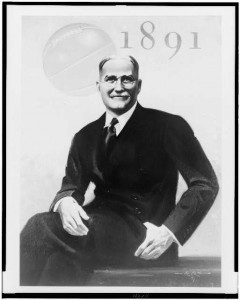
James Naismith, photograph of a 1941 oil painting by Lon Keller. Prints and Photographs Division.
This Spring, basketball celebrates a milestone—the 75th anniversary of “March Madness,” the annual National Collegiate Athletic Association (NCAA) Division 1 basketball series. For both men’s and women’s basketball, these tournaments determine the national champions of college basketball. In 1938, Ohio State University coach Harold Olsen conceived the idea, and the following year the first tournament was staged, with Oregon defeating Ohio State, 46-33.
The history of basketball is well-documented in the Library’s collections. The game was invented in 1891 at the YMCA Training Center in Springfield, Mass., by Canadian-American sports coach James Naismith, who founded the University of Kansas basketball program. The game gained popularity as a college sport for men and women. The Library’s “Today in History”web page notes that on Jan. 16, 1896, the first unofficial college basketball game was played between the University of Iowa and the University of Chicago—with five players on each side. Chicago won by a score of 15 to 12.
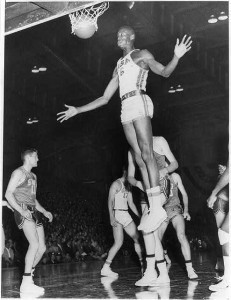
Bill Russell of the San Francisco Dons sinks a basket in the 1956 NCAA semifinals. Prints and Photographs Division
The Library of Congress photographic collections contain various nods to the sport, dating to the turn of the last century. The Prints and Photographs Online Catalog includes many action shots such as an airborne Bill Russell, of the University of San Francisco Dons, sinking a basket against Southern Methodist University in the semi-finals of the 1956 NCAA tournament.
The holdings of the Library’s Recorded Sound Section include radio highlights from games of the late 1940s and 1950s and more extensive radio and television coverage from the 1960s, featuring future NBA greats such as Jerry Lucas, Gail Goodrich, Bob Lanier, Bill Bradley and Kareem Abdul Jabbar. Two recent acquisitions—the John Miley Sports Broadcast Collection and the Sports Byline Collection—capture some rare moments in sports history.
“Hoosier Hysteria” is what they call the annual high school basketball tournament in Indiana—a state that has produced thousands of first-rate basketball players and boasts five NCAA championships. Hoosier Hysteria is documented in the Library’s American Folklife Center collections as part of the Local Legacies project that was launched in 2000 to recognize events and customs throughout the nation during the Library’s bicentennial celebration. The collection, which was submitted to the Library by Indiana Sen. Richard G. Lugar, chronicles the significant events, teams and moments in Indiana high school basketball history through videos, photographs, newspaper clippings and other memorabilia.
FACT: After attending a state basketball finals game in Indiana in 1925, the game’s inventor, James Naismith, said, “Basketball really had its origin in Indiana, which remains the center of the sport.”
This article is featured in the March-April 2013 issue of the Library of Congress Magazine, LCM, now available for download here. You can also view the archives of the Library’s former publication from 1993 to 2011.
March 20, 2013
Kaye and Fine Online
Growing up, I loved to watch old movies, in particular movie musicals. Of those, I remember “Hans Christian Andersen” starring Danny Kaye. It would turn up from time to time on television, so naturally I felt compelled to watch it. I haven’t seen the movie in years, but the Library’s online presentation, The Danny Kaye and Sylvia Fine Collection, which is new today, has certainly prompted me to revisit my childhood and even dig a little deeper into the life of the noted actor and comedian.
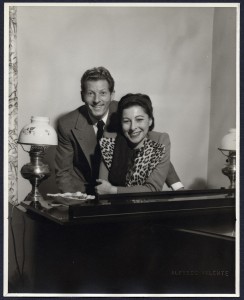
Danny Kaye and Sylvia Fine posing at piano in their home. Photograph by Alfredo Valente. Library of Congress Music Division.
More than 2,000 items cover the lives and careers of Kaye and his wife, Sylvia Fine, who played a major role in her husband’s success, writing the music and lyrics for his songs and artfully managing and producing his engagements.
“The items found on this website are informative, entertaining and enlightening,” said Daniel Walshaw, curator of the collection. “There are the stories people know, stories people do not know and there are the stories behind those stories. It shows not only the beautifully polished final products, such as films, recordings and shows, but it also shows the sweat, blood, tears and thousands of pots of black coffee that went into creating Danny Kaye and Sylvia Fine.”
A standout feature in the presentation is an interactive timeline that can be used to quickly browse the events in their lives with corresponding collection items like music scores, awards and audio-visual materials highlighting those particular periods.
In 1990, Sylvia Fine made an initial donation to the Library of Congress to form the Danny Kaye and Sylvia Fine Collection. In recent years, more items have been received from their daughter Dena Kaye and the Danny Kaye and Sylvia Fine Foundation to supplement the collection.

Baby Dena Kaye and Danny Kaye eating cake. Library of Congress Music Division.
This weekend, the Library is hosting a series of film screenings in celebration of Kaye and his wife Sylvia. In fact, Dena was here last night to kick things off and will be back for a question-and-answer session during the screenings.
In a short film shown about Kaye and Fine, comedian Carl Reiner talked about his memories of the “unmatchable and wonderful” Danny Kaye. “When he came onstage, it was like a jewel coming on stage – with his bright, red hair and sparkling smile.”
You can read more about Danny Kaye and Sylvia Fine in this previous blog post from the Library of Congress blog.
March 11, 2013
InRetrospect: February Blogging Edition
Here’s a sampling of some of the highlights in the Library’s blogosphere from February.
Inside Adams: Science Technology & Business
Turf Wars on the Football Field
Jennifer Harbster debates the differences between natural and synthetic turf grass on the football field.
In the Muse: Performing Arts Blog
In Memory of Patty Andrews and the Andrews Sisters
Chris Hartten and Mark Horowitz remember Andrews Sister front woman Patty Andrews.
In Custodia Legis: Law Librarians of Congress
Pres. George Washington gives advice to the new nation.
The Signal: Digital Preservation
After the Flood: Digital Art Recovery in the Wake of Hurricane Sandy
A New York City art gallery documents recovery efforts after Hurricane Sandy.
Teaching with the Library of Congress
Library of Congress resources highlight friendship between Lincoln and Douglass.
Picture This: Library of Congress Prints & Photos
What do the photographs tell you about the successful scientist, inventor and educator?
From the Catbird Seat: Poetry & Literature at the Library of Congress
The Poet Laureate is in residence and receiving guests.
March 8, 2013
Inquiring Minds: It’s All in a Word
With pop culture changing at such a rapid pace, it’s no wonder our language changes with the times as well. Here today, gone tomorrow as they say. I wonder where that phrase came from?
Barry Popik has made it his passion to discover word and phrase etymology. A lawyer and writer, Popik is a contributor to the “Oxford English Dictionary,” “Dictionary of American Regional English,” “Historical Dictionary of American Slang,” “Yale Book of Quotations” and “Dictionary of Modern Proverbs.” Since 1990 he has also been a regular contributor to Gerald Cohen’s newsletter, “Comments on Etymology.” He is recognized as an expert on the origins of the terms Big Apple, Windy City, hot dog and many other food terms, and he is an editor of the “Oxford Companion to American Food and Drink.”
Popik has often used the Library of Congress’s historic American newspaper database, “Chronicling America,” to uncover the truth behind our idioms.
While living in New York, Popik really became interested in etymology while doing his own work on the origin of “the Big Apple.”
“I felt that it was important enough to find the exact source and to find out if people were still living who knew anything on the subject,” he said.
That one phrase launched a hobby that would also later spawn a blog of the same name with more than 8,500 entries on the etymology of words.
“My website features Americanisms, and I prefer modern terms,” he said. “If it’s an expression used in the newspaper or on popular blogs, I’ll try to find its origin. I’m interested in terms about New York (where I used to live), Texas (where I now live), finance, politics, sports, food and the media.”
Most of Popik’s work was originally done using resources at the New York Public Library in the 1990s, “before blogs and Google and just about everything we’ve grown accustomed to.” However, he would find himself heading to the Library of Congress every few months to research the things he couldn’t find at NYPL.
“Most notably, I debunked the myth that Chicago’s nickname, ‘the Windy City,’ was born because of the 1893 Columbian Exposition, he explained. “I showed that the term was popularized by the Cincinnati newspapers in the 1860s.”
He looked to the Library’s cookbooks and old telephone books to research food and food names. “I found ‘sub’ sandwiches that were first cited from Delaware sandwich shops.”
Popik’s blog lists more than 220 posts on word origins that reference “Chronicling America.”
“I use every tool that I can get,” he said. “I prefer to cite free resources, so that any reader of my work can make a click and find the original article. Things change and technology certainly changes, but they’re both the same idea. It’s nice to know there’s a place where you can find this stuff.”
One of Popik’s interesting discoveries using Chronicling America concerned the word “hamburger.” When he first moved to Texas in late 2006, a legislator was trying to push a bill through that stated “hamburger” was first popularized by Fletcher Davis of Athens, Texas, at the 1904 World’s Fair in St. Louis.
“I tried to tell everyone that the story was bogus, but no one would respond to me and the bill passed into law unopposed,” he said.
According to Popik, “Chronicling America” shows that “hamburger steak sandwiches” were served in Shiner, Texas, in April 1894, before Fletcher Davis arrived in Athens and well before the 1904 World’s Fair.
“Words and phrases have an origin and a reason for being – it’s a history,” he concluded. “Meanings can change, and nothing is fixed forever. But if people don’t know the history of words and names and phrases, then they have no guide.
“People these days have been citing George Washington, Thomas Jefferson and Benjamin Franklin, but in many cases, I’ve found that the quotations were really modern inventions. What did Thomas Jefferson really say about guns or about banking? To some people that might be trivia, but we live under documents such as the Declaration of Independence and the Constitution that are composed of words and phrases. It sure would be nice to know what they mean.”
Library of Congress's Blog
- Library of Congress's profile
- 74 followers



